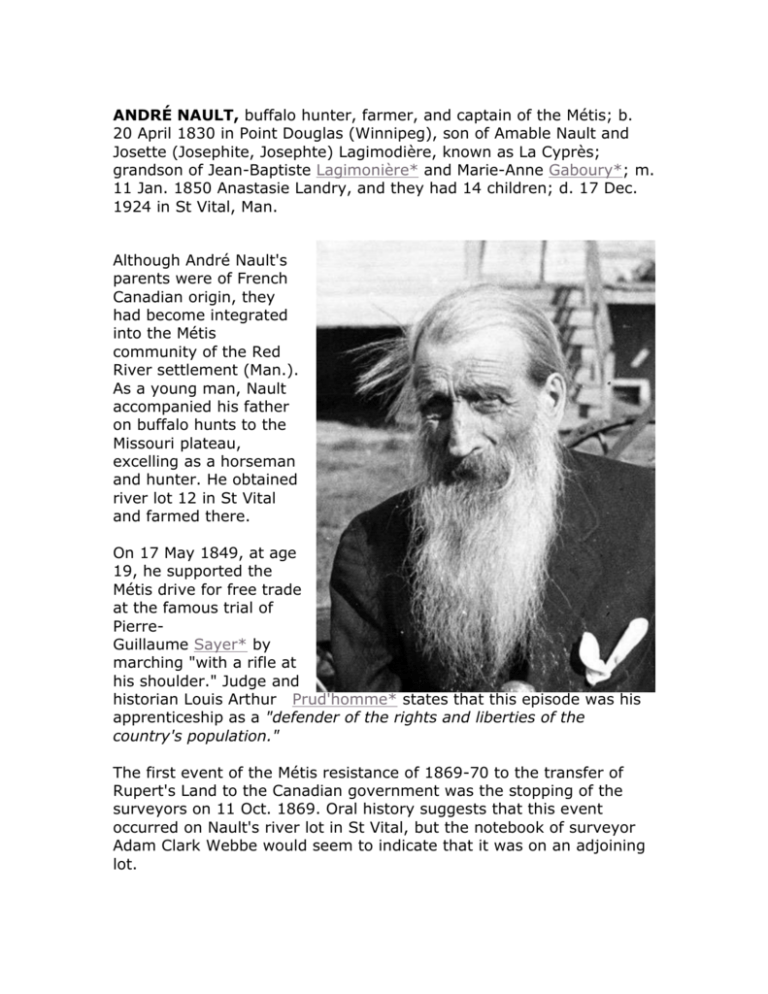André Nault: Métis Leader Biography & Red River Resistance
advertisement

ANDRÉ NAULT, buffalo hunter, farmer, and captain of the Métis; b. 20 April 1830 in Point Douglas (Winnipeg), son of Amable Nault and Josette (Josephite, Josephte) Lagimodière, known as La Cyprès; grandson of Jean-Baptiste Lagimonière* and Marie-Anne Gaboury*; m. 11 Jan. 1850 Anastasie Landry, and they had 14 children; d. 17 Dec. 1924 in St Vital, Man. Although André Nault's parents were of French Canadian origin, they had become integrated into the Métis community of the Red River settlement (Man.). As a young man, Nault accompanied his father on buffalo hunts to the Missouri plateau, excelling as a horseman and hunter. He obtained river lot 12 in St Vital and farmed there. On 17 May 1849, at age 19, he supported the Métis drive for free trade at the famous trial of PierreGuillaume Sayer* by marching "with a rifle at his shoulder." Judge and historian Louis Arthur Prud'homme* states that this episode was his apprenticeship as a "defender of the rights and liberties of the country's population." The first event of the Métis resistance of 1869-70 to the transfer of Rupert's Land to the Canadian government was the stopping of the surveyors on 11 Oct. 1869. Oral history suggests that this event occurred on Nault's river lot in St Vital, but the notebook of surveyor Adam Clark Webbe would seem to indicate that it was on an adjoining lot. Homestead, Andre Nault, Winnipeg, 1920. Nault's first name is not listed among those of the seven Naults who were present, but the one nicknamed Nanin is assumed to have been him. On the arrival of the surveyors, Nault is said to have gone for his first cousin Métis leader Louis Riel*, who spoke English. It seems likely that Nault played a significant role on this occasion since oral accounts of the event link it to his property. According to Nault, at a meeting of the Métis on 21 Oct. 1869 Riel ordered him to construct a barrier at St Norbert to prevent the lieutenant governor designate, William McDougall*, from entering the Red River settlement or bringing in arms. Nault had about 250 to 300 men with him. On 1 November he and his brother Benjamin forced McDougall's representatives, Captain Donald Roderick Cameron and Joseph-AlfredNorbert Provencher*, to return to Pembina (N.Dak.). The following day, under Riel's orders, he and his men captured Upper Fort Garry (Winnipeg) to prevent it from falling into the hands of John Christian Schultz*and his Canadian supporters. From 4 to 23 Dec. 1869 Nault occupied Fort Pembina, the HBC post just north of the international border, to watch the activities of McDougall. When McDougall headed back east, Nault returned to the Red River settlement. Prud'homme argues that in Riel's provisional government Nault was probably fourth in line of importance after Riel, AmbroiseDydime LÉPINE, and Elzéar Goulet*. Nault was a member of the court martial that on 3 March 1870 tried Thomas Scott*, an Ontarian captured in mid February. Scott had proved to be a particularly troublesome prisoner and was sentenced to execution. Nault, who commanded the Métis firing squad, would report in 1923 to historian Auguste-Henri de TRÉMAUDAN that Scott "did not believe that we would have the pluck, as he called it, to go the whole length and to shoot him." Scott "would pledge his word to keep the peace in order to be released, then break it as soon as he was free. We had no desire whatever to put him to death, he simply forced us to it." After troops arrived in August 1870 under the command of Colonel Garnet Joseph Wolseley*, numerous Métis suffered reprisals. In February 1871 Nault was attacked by soldiers at Pembina and left for dead. Prud'homme observed that he carried the scar from this brutal incident until his death. Later in 1871 Nault played a significant role in obtaining information for Riel and the Métis on the movements of William Bernard O'Donoghue*, who had asked Métis leaders, Nault included, for support in attacking Manitoba with a band of Fenians. Nault and Jean-Baptiste Lépine* went to Pembina on 2 October and returned four days later to report that O'Donoghue was planning to attack Fort Pembina before approaching Fort Garry. The Métis under Riel stayed loyal to Canada and did not join O'Donoghue. In late 1871 Riel suggested the formation of an association of Métis to maintain their influence in the Red River parishes and he looked to Nault as one of the "principal Métis." Nault was named a councilor of the new organization, the Union Saint-Alexandre. Despite the hopes of Métis leaders that their demonstration of loyalty in protecting the colony against the Fenians, would help them obtain amnesty for acts carried out during the resistance, they remained disappointed. Nault was arrested in February 1874. He stood trial for the murder of Scott the following November, but the jury was unable to reach a verdict. He was in prison awaiting a second trial when the government of Alexander Mackenzie* granted a full amnesty to all except Riel, A. D. Lépine, and O'Donoghue in February 1875. His imprisonment left him with heart and lung problems. After his release he returned to his St Vital farm, where he would live until age 94. “Andre and Anastasie Nault, Diamond Anniversary Party, He took no part in the events of 1885 in Saskatchewan, but three of his sons did. He became a member of the Union Nationale Métisse Saint-Joseph du Manitoba, established in 1887 to preserve Métis heritage and culture. An example of his efforts to collect and document Métis history was his donation in 1910 of the original flag of the Union Nationale Métisse to the organization; it is now preserved in the Heritage Centre of the Société Historique de Saint-Boniface. The Métis and francophone communities of Manitoba and André Nault's numerous descendants continue to honour the memory of this man who was an eye-witness to, and participant in, many stirring events. http://www.biographi.ca/en/bio.php?id_nbr=8307 http://www.shsb.mb.ca/bulletin/nault. htm "The diamond wedding anniversary party for André Nault, a cousin of Louis Riel and a member of Riel's Provisional Government, and his wife Anastasie, St. Vital, Oct 19, 1910." Nault was very involved in the Métis community, although he himself was of French-Canadian descent. Key in Métis activism since his late teens, Nault participated as a leader in the Métis Resistance of 1869-1870, and actually commanded the firing squad that executed Thomas Scott. Of course, this was done under the guidance of his first cousin, Louis Riel. For one year, Nault was imprisoned on account of Scott’s murder, but was eventually acquitted. Nault lived at River Lot 12. André Nault’s wife, Anastasie was the daughter of an Acadian fur trader, Joseph Landry, she was one of twelve children; her mother was Geneviève Lalonde. It is interesting to note that Anastasie along with five of her siblings married into the same two families, the Nault and Bruneau families (both prominent Métis and French-Canadian families). Photographer: Lewis Benjamin Foote http://lostfootephotos.blogspot.ca/2012/07/favourite-foote-photos-caitlyn-carson.html Andre Nault (1830-1924) Obituary Finally was able to see the obituary entitled 'Andre Nault is Dead, Ft. Garry Mourns', which appeared on p. 1 of the Winnipeg Tribune on December 18, 1924. Thanks to Lyle Brennen for sending it to me (along with a biography I haven't seen before possibly from the Tribune as well entitled 'Andre Nault, Riel Rebellion Veteran, Dies' with the amusing sub-title 'Nonagenarian was the Discoverer of English Surveyors, Cause of Trouble'), plus a Manitoba Free Press obituary I was unaware of as well entitled 'Andre Nault, Veteran of Riel Times, Dead', which was published the same day. That Andre's death was front page news (p. 1) in the Tribune seems highly significant to me as anything on page 1 of a city newspaper is considered most newsworthy. So it is yet another indication of Nault's importance in Metis, Manitoban and Canadian history, the sense of which has been lost over time. Among the interesting details from the obituaries (other than that Andre was the 'cause of trouble' at Red River are some actual quotes from my great-great grandfather and his views on the meaning of the Red River Resistance. To quote the Tribune obituary on what Andre Nault thought the events of 1869-70 at Red River represented: 'It was not a rebellion', he insisted whenever the matter was referred to, even in his last years. 'We were merely desirous of preserving our rights and getting justice. It was our due that the Dominion government should consult us in reference to matters pertaining to government in the colony'. According to the same Tribune obituary, for his role in the events at Red River in 1869-70 he was attacked by 'a soldier' with a rifle butt and left for dead near the US border*. [13/08/11: *The article has a few errors and omissions here. The assailants were actually a group of 15 RRAF (Red River Expeditionary Force) Volunteers who were identified yet not charged and some accounts say Nault was bayoneted as opposed to being struck by a rifle butt. Occupying Red River in August 1870 after the region was annexed by Canada, the RRAF were a militia of 1,200 men from Ontario (many of them Orangemen) and Quebec under the command of British Army Colonel Garnet Wolseley. Often taking matters into their own hands and disobeying their officers, members of the RRAF hoped to exact revenge for the death of Thomas Scott, drive Metis off their lands, and encourage settlers from Ontario to enter the region. They were a key component of the 'Reign of Terror' from 1870-72 in Red River in which Metis were assaulted and in many cases killed, one victim being Andre Nault, who fortunately survived a particularly brutal attack (not the only time he was attacked, by the way). The article does not provide these details and also incorrectly states that Nault was 54 years old at the time, but the attack occurred in March, 1871, when Andre was still 40 years old. I will write something about this period later as I have some more information on Andre Nault during these events.] He managed to survive, but was left with a permanent reminder of the attack in the form of a gash on his head which one could pass one's fingers through. I had read elsewhere that he had a scar, but the actual groove in his skull shows how severe the wound actually was. To evade arrest, Nault spent two years in the United States. But as his wife Anastasie did not wish to live in exile, he returned to Manitoba, was arrested in 1874 for his role in the execution of Thomas Scott, and served one year in prison. (It does not mention it in either obituary, but Nault served on the jury that voted for Scott's execution, guided Scott to the execution area, waved the flag for the execution squad, and helped hide Scott's corpse, which was never found). The obituary from the Manitoba Free Press includes a quote from Andre regarding his year spent in prison: 'I will never forget the year I spent in prison', he remarked to a Free Press reporter some time ago, 'that I, who upheld justice, right and the British flag should have been imprisoned by the servants of that same great flag'. The obituary neglects to mention that this quote was in reference to Nault's not siding with William Bernard O'Donoghue, a former Treasurer in Riel's ill-fated Provisional Government who, being of Irish descent, supported the Fenian cause and had petitioned the United States president U.S. Grant for intervention in Red River on behalf of the Metis, raising the possibility of American annexation of the Red River region. According to Canadian Biography, 'Nault and Jean-Baptiste Lépine went to Pembina on 2 October [1871] and returned four days later to report that O'Donoghue [with 35 men] was planning to attack Fort Pembina before approaching Fort Garry. The Métis under Riel stayed loyal to Canada and did not join O'Donoghue' (NAULT, ANDRÉ, Dictionary of Canadian Biography; URL: http://www.biographi.ca/009004119.01e.php?&id_nbr=8307&interval=25& ) http://ucalgary.academia.edu/DerrickNault/Posts/314795/Andre_Nault_18301924_Obituaries







